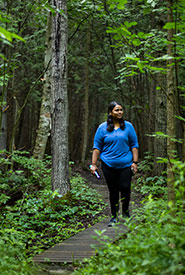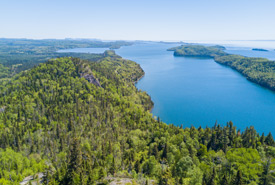Mutual benefits

A visitor enjoying a leisurely stroll on a boardwalk in a lush, green forest (Photo by Nila Sivatheesan/NCC staff)
Spending time in nature provides us with significant mental and physical health benefits. But, to get the most out of our relationship with nature, we have to offer something in return.
Nature is extremely generous with us. Collectively, it provides us with countless invaluable ecosystem services. On a personal basis, it provides us with significant mental and physical health benefits, and it can help build connections between people. These benefits have long been recognized by belief systems and cultures that foster a connection to nature. Many health-care systems, including British Columbia’s and Ontario’s, now recognize these benefits and are providing people with nature prescriptions. These prescriptions encourage patients to spend time in nature for its mental and physical benefits. But for our relationship with nature to be truly win-win, we need to ask ourselves: what can we offer in return? The good news is that the answer isn’t complicated. With a little bit of goodwill and through some simple acts, we can spend time in nature in ways that are respectful and sustainable.
These seven simple tips will help you enter a mutually beneficial relationship with nature:

Big Trout Bay, Lake Superior, ON (Photo by Costal Productions)
1. Choose your destination
Find destinations that aren’t heavily trafficked, and explore hidden gems. Such places aren’t less interesting; they are just less well-known, and the experience will be equally rewarding. If you still want to visit popular places, visit them at times and periods when there are fewer people, such as during slower seasons or on quieter weekdays. This way, you will contribute to lowering the cumulative impact of recreational use.
2. Choose your activities
Make sure the activities you want to practice are allowed on-site, by reading about the location beforehand or consulting any signage once you’ve arrived. Guidelines differ from place to place but they are equally important in helping you visit the place safely and responsibly. Choose activities that are low impact on the environment, such as hiking, paddling or other non-motorized activities.
3. What to bring
Bring everything you need for your visit and bring it all back with you. This includes packing in food and water and packing out any refuse your visit may have generated. This way, you will contribute to keeping nature clean and free of potential wildlife attractants and hazards.
4. What to take home
Take only pictures when visiting nature. The best souvenirs are experiential, and anything you take with you cannot be enjoyed by other visitors.
5. You're not alone
Remember that you share the place with others who may be practicing different activities. On land, yield to faster visitors or those walking uphill and, on water, give priority to non-motorized vessels. If travelling with pets, always keep them under your control and on-leash to avoid unwanted interactions with wildlife and other visitors and their pets. Being mindful of others allows everyone to have a positive experience. Courtesy and a smile can go a long way!
6. Wildlife is present
You will also be sharing the place with wildlife. If you are privileged enough to encounter wild animals, remember to keep a safe distance from them, for their safety and for yours, and to avoid any interactions with them.
7. Be a champion for conservation
You can lend nature a helping hand and support our on-the-ground conservation work by joining a Conservation Volunteers event or contributing to our stewardship work at natureconservancy.ca/donate.
This story originally appeared in the fall 2021 issue of the Nature Conservancy of Canada Magazine. To learn more about how you can receive the magazine, click here.
Explore additional content from our fall issue here >



